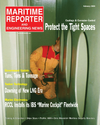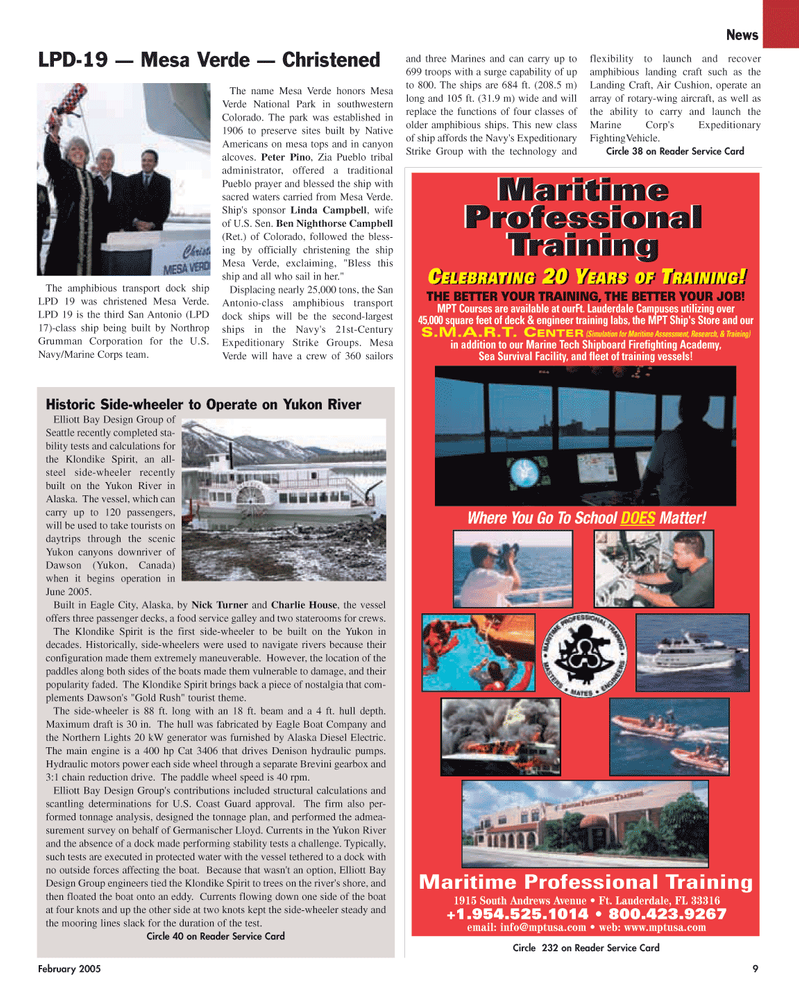
Page 9: of Maritime Reporter Magazine (February 2, 2005)
Read this page in Pdf, Flash or Html5 edition of February 2, 2005 Maritime Reporter Magazine
February 2005 9
The amphibious transport dock ship
LPD 19 was christened Mesa Verde.
LPD 19 is the third San Antonio (LPD 17)-class ship being built by Northrop
Grumman Corporation for the U.S.
Navy/Marine Corps team.
The name Mesa Verde honors Mesa
Verde National Park in southwestern
Colorado. The park was established in 1906 to preserve sites built by Native
Americans on mesa tops and in canyon alcoves. Peter Pino, Zia Pueblo tribal administrator, offered a traditional
Pueblo prayer and blessed the ship with sacred waters carried from Mesa Verde.
Ship's sponsor Linda Campbell, wife of U.S. Sen. Ben Nighthorse Campbell (Ret.) of Colorado, followed the bless- ing by officially christening the ship
Mesa Verde, exclaiming, "Bless this ship and all who sail in her."
Displacing nearly 25,000 tons, the San
Antonio-class amphibious transport dock ships will be the second-largest ships in the Navy's 21st-Century
Expeditionary Strike Groups. Mesa
Verde will have a crew of 360 sailors and three Marines and can carry up to 699 troops with a surge capability of up to 800. The ships are 684 ft. (208.5 m) long and 105 ft. (31.9 m) wide and will replace the functions of four classes of older amphibious ships. This new class of ship affords the Navy's Expeditionary
Strike Group with the technology and flexibility to launch and recover amphibious landing craft such as the
Landing Craft, Air Cushion, operate an array of rotary-wing aircraft, as well as the ability to carry and launch the
Marine Corp's Expeditionary
FightingVehicle.
Circle 38 on Reader Service Card
Maritime
Professional
Training
Maritime Professional Training 1915 South Andrews Avenue • Ft. Lauderdale, FL 33316 +1.954.525.1014 • 800.423.9267 email: [email protected] • web: www.mptusa.com
Where You Go To School DOES Matter!
THE BETTER YOUR TRAINING, THE BETTER YOUR JOB!
MPT Courses are available at ourFt. Lauderdale Campuses utilizing over 45,000 square feet of deck & engineer training labs, the MPT Ship's Store and our
S.M.A.R.T. CENTER (Simulation for Maritime Assessment, Research, & Training) in addition to our Marine Tech Shipboard Firefighting Academy,
Sea Survival Facility, and fleet of training vessels!
CELEBRATING 20 YEARS OF TRAINING!
Circle 232 on Reader Service Card
News
LPD-19 — Mesa Verde — Christened
Historic Side-wheeler to Operate on Yukon River
Elliott Bay Design Group of
Seattle recently completed sta- bility tests and calculations for the Klondike Spirit, an all- steel side-wheeler recently built on the Yukon River in
Alaska. The vessel, which can carry up to 120 passengers, will be used to take tourists on daytrips through the scenic
Yukon canyons downriver of
Dawson (Yukon, Canada) when it begins operation in
June 2005.
Built in Eagle City, Alaska, by Nick Turner and Charlie House, the vessel offers three passenger decks, a food service galley and two staterooms for crews.
The Klondike Spirit is the first side-wheeler to be built on the Yukon in decades. Historically, side-wheelers were used to navigate rivers because their configuration made them extremely maneuverable. However, the location of the paddles along both sides of the boats made them vulnerable to damage, and their popularity faded. The Klondike Spirit brings back a piece of nostalgia that com- plements Dawson's "Gold Rush" tourist theme.
The side-wheeler is 88 ft. long with an 18 ft. beam and a 4 ft. hull depth.
Maximum draft is 30 in. The hull was fabricated by Eagle Boat Company and the Northern Lights 20 kW generator was furnished by Alaska Diesel Electric.
The main engine is a 400 hp Cat 3406 that drives Denison hydraulic pumps.
Hydraulic motors power each side wheel through a separate Brevini gearbox and 3:1 chain reduction drive. The paddle wheel speed is 40 rpm.
Elliott Bay Design Group's contributions included structural calculations and scantling determinations for U.S. Coast Guard approval. The firm also per- formed tonnage analysis, designed the tonnage plan, and performed the admea- surement survey on behalf of Germanischer Lloyd. Currents in the Yukon River and the absence of a dock made performing stability tests a challenge. Typically, such tests are executed in protected water with the vessel tethered to a dock with no outside forces affecting the boat. Because that wasn't an option, Elliott Bay
Design Group engineers tied the Klondike Spirit to trees on the river's shore, and then floated the boat onto an eddy. Currents flowing down one side of the boat at four knots and up the other side at two knots kept the side-wheeler steady and the mooring lines slack for the duration of the test.
Circle 40 on Reader Service Card
MR FEBRUARY 2005 #2 (9-16).qxd 2/2/2005 9:07 AM Page 1

 8
8

 10
10
